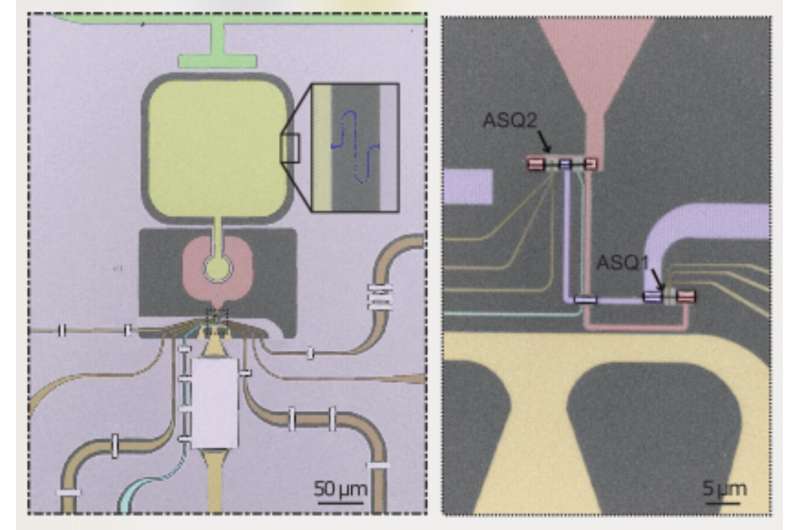
The complete chip mounted on a printed circuit board. Credit: Pita-Vidal, Wesdorp et al.
Quantum computers, computing devices that use the principles of quantum mechanics, can outperform classical computing in some complex optimization and processing tasks. In quantum computers, the classical units of information (bits), which can have the value 1 or 0, are replaced by quantum bits or qubits, which can be a mixture of both 0 and 1 simultaneously.
Qubits have so far been realized using various physical systems, ranging from electrons to photons and ions. In recent years, some quantum physicists have been experimenting with a new type of qubit, known as Andreev spin qubits. These qubits use the properties of superconducting and semiconductor materials to store and manipulate quantum information.
A team of researchers at Delft University of Technology, led by Marta Pita-Vidal and Jaap J. Wesdorp, recently demonstrated strong and tunable coupling between two distant Andreev spin qubits. Their paper, published in Nature Physicsmay pave the way to the effective realization of two-qubit gates between distant spins.
“The latest work is essentially a continuation of our work published last year in Nature PhysicsChristian Kraglund Andersen, corresponding author of the paper, told Phys.org. “In this previous work, we studied a new type of qubit called the Andreev spin qubit, which was also previously demonstrated by researchers at Yale.”
Andreev spin qubits simultaneously use the favorable properties of superconducting and semiconductor qubits. These qubits are essentially created by inserting a quantum dot into a superconducting qubit.
“With the new qubit established, the next natural question was whether we could bring two of them together,” Andersen said. “A theoretical paper published in 2010 suggested a method for pairing two such qubits, and our experiment is the first to realize this proposal in the real world.”

A zoom in on the device. On the left, a superconducting qubit (red) is shown coupled with the readout and control lines. The two Andreev spin qubits are sitting in the small dashed box. On the right is a zoom in on the part with two Andreev spins sitting on two superconducting loops. Credit: Pita-Vidal, Wesdorp et al.
As part of their study, Andersen and his colleagues first created a superconducting circuit. Next, they deposited two semiconductor nanowires on top of this circuit using a precisely controlled needle.
“The way we designed the circuit, the combined nanowire and superconducting circuits created two superconducting loops,” Andersen explained. “The special part of these loops is that one part of each loop is a semiconductor quantum dot. In the quantum dot, we can trap an electron. The most interesting thing is that the current flowing around the loops will now depend on the spin of the electron blocked This effect is interesting, as it allows us to control a supercurrent of billions of Cooper pairs with a single spin.
The combined current of the two superconducting loops realized by the researchers ultimately depends on the spin in both quantum dots. This also means that the two spins are connected via this supercurrent. Notably, this coupling can also be easily controlled, either via the magnetic field passing through the loops or by modulating the gate voltage.
“We demonstrated that we can indeed couple spins over ‘long’ distances using a superconductor,” Andersen said. “Normally, spin-spin coupling occurs only when two electrons are very close. When comparing semiconductor-based qubit platforms to those based on superconducting qubits, this proximity requirement is one of the architectural downsides of semiconductors.”
Superconducting qubits are known to be bulky, thus taking up a lot of space inside a device. The new approach introduced by Andersen and his colleagues allows greater flexibility in the design of quantum computers, enabling qubits to be coupled over long distances and packed closer together.
This latest research could soon open up new possibilities for the development of high-performance quantum computing devices. In their future studies, the researchers plan to extend their proposed approach to a larger number of qubits.
“We have very good reason to think that our approach could provide significant architectural advances for coupling multiple spin qubits,” Andersen added. “However, there are also experimental challenges. The current coherence times are not very good, and we expect that the core spin bath of the semiconductor (InAs) we used is to blame. So we would like to switch to a cleaner platform , for example based on germanium, to increase the coherence time.”
More information:
Marta Pita-Vidal et al, Strong tunable coupling between two distant superconducting spin qubits, Nature Physics (2024). DOI: 10.1038/s41567-024-02497-x
© 2024 Science X Network
citation: Tunable Coupling of Two Distant Superconducting Spinning Qubits (2024, May 22) Retrieved May 22, 2024 from https://phys.org/news/2024-05-tunable-coupling-distant-superconducting-qubits.html
This document is subject to copyright. Except for any fair agreement for study or private research purposes, no part may be reproduced without written permission. The content is provided for informational purposes only.
#Tunable #coupling #distant #superconducting #spin #qubits
Image Source : phys.org